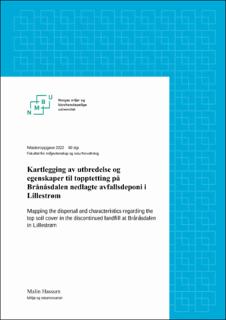| dc.contributor.advisor | French, Helen Kristine | |
| dc.contributor.author | Hassum, Malin | |
| dc.coverage.spatial | Norway, Akershus, Lillestrøm | en_US |
| dc.date.accessioned | 2022-09-29T09:51:18Z | |
| dc.date.available | 2022-09-29T09:51:18Z | |
| dc.date.issued | 2022 | |
| dc.identifier.uri | https://hdl.handle.net/11250/3022510 | |
| dc.description.abstract | Studiet har kartlagt Brånåsdalen sitt tildekkede avfallsdeponi gjennom ERT undersøkelser, jordprøver og infiltrasjonsmålinger.
I ERT undersøkelsene er trolig øvregrensen ned til fjell, identifisert. Det var ikke mulig skille deponerte avfallsmasser fra topptetting og underliggende marin leire. Avgrensede avfallsceller med lave resistivitetsverdier er gjennomgående. Det kan tyde på at ytre deponigrensen streker seg lengre utover i horisontal enn tidligere antatt.
Vannledningsevnen K [m/s] varierer stort mellom enkeltpunkter, men samsvarer med klassifisering av jordart fra kornfordelingsanalyse. Korngraderingen virker tilstrekkelig for å opprettholde fuktighet og sørge for kontrollert infiltrasjon av nedbør. Tykkelsen og innholdet av organisk materiale i toppdekket er ikke tilfredsstillende. Det gir en økt risiko for erosjon og uttørking av det impermeable tetningslaget.
Dette studiet har vist at kombinasjon av flere metoder for å kartlegge toppdekkets egenskaper vil være optimalt. Ved å stille krav til feltbeskrivelser, analysemetoder og spesifikke krav til massene i toppdekket vil faglig skjønn og antagelser begrenses. | en_US |
| dc.description.abstract | The extent of the landfill boundary and cover layer at Brånåsdalen landfill were characterized through ERT surveys, soil analysis and infiltration measurements.
The ERT survey identifies a possible boundary between the sediments and bedrock. Due to several factors, it was not possible to differentiate the cover layer from the underlying landfilled material. The ERT survey also indicates that the landfill border may extend further laterally than previously assumed.
The infiltration tests show large variations in the hydraulic conductivity between each sample location. The water conductivity aligns with the soil grain distribution analysis at each respective sample location. This suggests that there is sufficient water conductivity to retain enough moisture in the upper layer to prevent excessive infiltration which could damage the soil cover layer. The thickness of this upper layer, as well as the amount of organic material is insufficient. Due to the insufficient thickness, the landfill soil and clay cover layers are at increased risk of damage through erosion and cracking due to drought and freeze/thaw effects.
This study has shown that a combination of several methods to map the top soil cover properties provides a more comprehensive picture of the condition of the top soil cover that will be optimal for assessment of function. By setting requirements for fields descriptions, analysis methods and specific requirements for the masses in the top soil cover, subjective judgment and assumptions will be limited. | en_US |
| dc.language.iso | nob | en_US |
| dc.publisher | Norwegian University of Life Sciences, Ås | en_US |
| dc.rights | Attribution-NonCommercial-NoDerivatives 4.0 Internasjonal | * |
| dc.rights.uri | http://creativecommons.org/licenses/by-nc-nd/4.0/deed.no | * |
| dc.title | Kartlegging av utbredelse og egenskaper til topptetting på Brånåsdalen nedlagte avfallsdeponi i Lillestrøm | en_US |
| dc.title.alternative | Mapping the dispersal and chara cteristics regarding the top soil cover in the discontinued landfill at Brånåsdalen in Lillestrøm | en_US |
| dc.type | Master thesis | en_US |
| dc.description.localcode | M-MINA | en_US |

